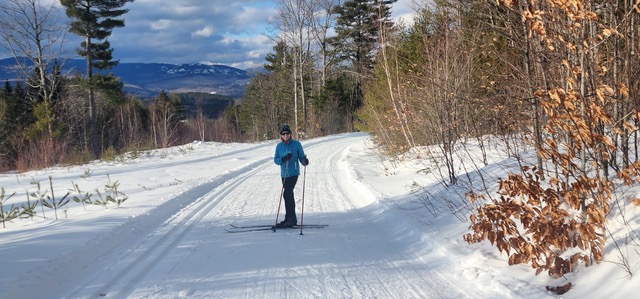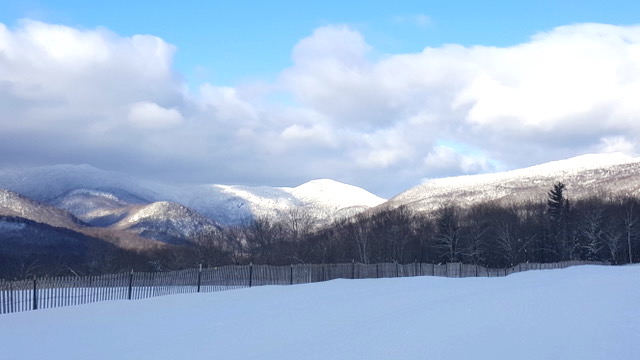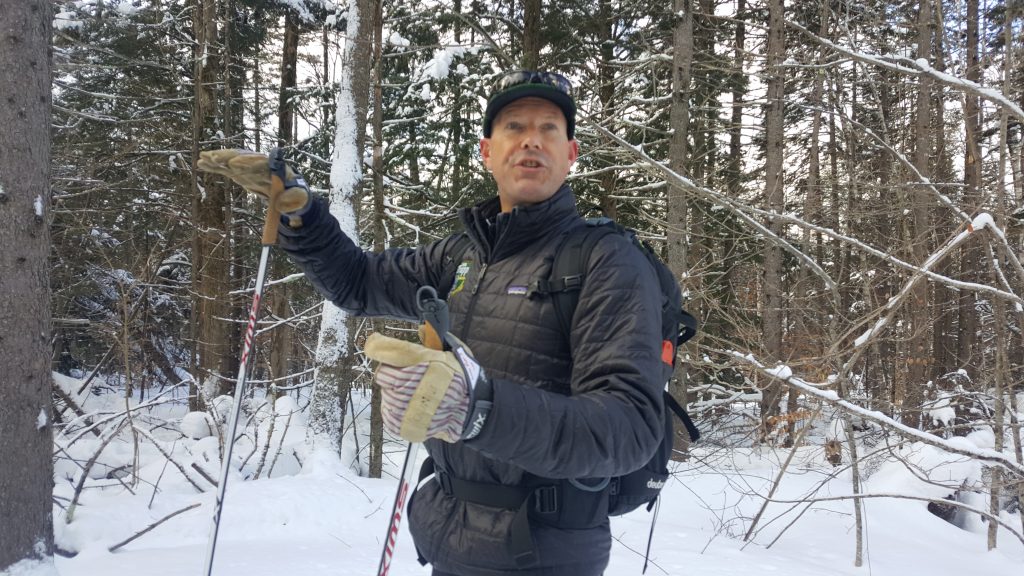
By Tamsin Venn
Trails in Maine, New Hampshire, and Vermont all beckon this time of year.
Many of us kayakers give up ocean in winter but not our desire to wander in the great outdoors, trading paddles for Nordic skis or snowshoes. Instead of crossing a tranquil sea or bouncing waves, we glide through forest, hill, and meadow. Not all who wander are lost, says J. R. R. Tolkien, and here are three favorite places to do that, grateful for public access.
The Inland Woods + Trails at the Bethel Inn in Maine has 15 miles of XC trails and nine miles of snowshoe/fat bike trails. At the end of last January, we skied crisp, fast trails. Post-rain, groomers had broken the icy crust and left a light, snowy trail, optimal conditions.
Some of the trail network here is newly located in the Chadbourne Forestlands, managed for timber harvesting, multi-use public recreation, and wildlife habitat, in the interest of preserving Western Maine’s timberland. Inland Woods has partnered with the Conservation Fund and the landowner, White Pine Forest LLC to manage the trails for the public and you are asked to respect private property plus timber operations.
Other trail users include moms with kids, speedy XC skaters, and snowshoers. Dogs are allowed on all snowshoe and fat-tire bike trails but only the Dog Days Nordic ski trail. Start at the Nordic center in the back of the Bethel Inn, take Tibbetts Loop and connectors out to the overlook at the upper reaches of Grover’s Grind, with a great view to the north to the back side of Locke Mountain at Sunday River. You can proceed to the end of Grover’s Grind, and then head back. Bonus, the Millbrook Tavern back at the inn has nightly winter specials. Wednesday is $10 burger night plus trivia. The rambling 18th century Bethel Inn is a short stroll down Main Street to the Maine Mineral & Gem Museum, which has Earth’s largest chunk of Mars in its collection.

Another favorite wander is Trapp Family Lodge in Stowe, Vt. Last Easter we skied up to the Slayton Pasture Cabin, a three-mile steady climb from the Nordic Center. The pasture is named after the farming family that once owned this hill-top acreage, a corner of the 2,600 acres of woods, rolling hills and meadows owned by the Trapp Family Lodge.
Normally, after a rest, hot stew and cocoa at the cabin, you scream back down back to the lodge but in the corn snow, we were on red alert to avoiding a sudden stop and launching like an un-guided missle. That did not happen. Johannes Trapp, with a degree from Yale Forestry School, cut the rolling loops through the woods and fields and created the first commercial Nordic center in the country in 1968.


Since it was Easter, Trapps brought out its lambs to entertain the children. Yes Rosemary Crusted Rack of Lamb was on the lodge menu.

Over in Lincoln, N.H., we enjoy the Lincoln Woods Trail on the Kancamagus Highway, a few miles down the road from Loon Mountain Resort. The dog-friendly trail starts at a large parking area, Lincoln Woods, follows the East Branch of the Pemigewasset River into the woods of the White Mountain National Forest. That leads into one of the largest roadless areas in the eastern US known as the Pemigewasset Wilderness.
Leaving the parking lot on skis or showshoes, you cross the East Branch of the Pemigewasset River on a 160-foot suspension bridge, then make a sharp right turn. Follow the river and the Lincoln Railroad’s old route, up to the Osseo trail juncture (1.4 miles) or the Black Pond trail juncture (2.8 miles). You can also hike to Franconia Falls, a favorite summer swimming spot.
An alternative is to follow the East Branch Road on the river’s other side, which may be less crowded. It is basically a flat easy run through the woods, just turn around when you feel like it. As with many wilderness trails, the farther out you go, the better the tracks. You pay a recreational user fee at the parking lot.


